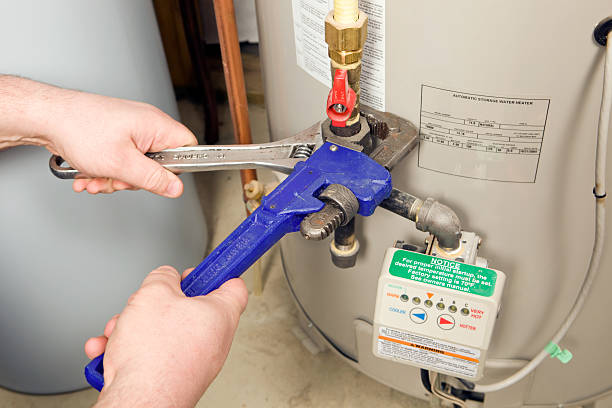
If you’re experiencing issues with your water heater, it can be a frustrating experience. A malfunctioning water heater can cause a lot of inconvenience and discomfort, especially during colder months. However, with the help of a professional, you can get your water heater back up and running in no time.
There are many reasons why your water heater might need repairs. It could be due to a faulty thermostat, a broken heating element, a malfunctioning pilot light, or a leaky tank. Whatever the issue may be, it’s important to get it fixed as soon as possible to avoid further damage and higher repair costs.
Common Water Heater Problems
When it comes to water heaters, there are a few common problems that can arise. Here are some of the most frequent issues you might encounter:
No Hot Water
If you turn on your hot water tap and nothing comes out, you may have a problem with your water heater. This issue can be caused by a faulty heating element, a tripped circuit breaker, or a blown fuse. It can also be due to a malfunctioning thermostat or a broken dip tube. In some cases, sediment buildup can cause a blockage in the water heater, preventing hot water from flowing through.
Inconsistent Water Temperature
If your water temperature fluctuates between hot and cold, it could be due to a faulty thermostat. The thermostat may be set too high or too low, or it may not be functioning correctly. Another possible cause of inconsistent water temperature is a buildup of sediment in the water heater tank. This can cause the water to heat unevenly, resulting in fluctuating temperatures.
Strange Noises
If you hear strange noises coming from your water heater, it could be a sign of a problem. One possible cause of strange noises is sediment buildup in the tank. As the sediment heats up, it can create popping or cracking sounds. Another possible cause of strange noises is a malfunctioning heating element. If the heating element is not functioning correctly, it can cause the water to boil, resulting in a rumbling or gurgling sound.
These are some of the most common water heater problems you might encounter. If you experience any of these issues, it’s important to address them as soon as possible to prevent further damage to your water heater. If you’re unsure how to fix the problem, it’s best to call a professional plumber to diagnose and repair the issue.
Water Heater Repair Services
When your water heater breaks down, you need to know what kind of repair services are available to you. Here are some common water heater repair services that you may need:
Diagnosis and Inspection
Before any repair work can be done, a diagnosis and inspection of the water heater is necessary. A professional technician will inspect your water heater and identify the problem. They will then provide you with a detailed report of the issue and an estimate of the repair costs.
Heating Element Replacement
If your water heater is not producing hot water, it may be due to a faulty heating element. A heating element replacement is a common repair service for electric water heaters. This involves removing the old heating element and replacing it with a new one. A professional technician can perform this repair quickly and efficiently.
Thermostat Replacement
If the temperature of your water is not consistent, it may be due to a faulty thermostat. A thermostat replacement is a common repair service for both electric and gas water heaters. This involves removing the old thermostat and replacing it with a new one. A professional technician can perform this repair quickly and efficiently.
In conclusion, there are several water heater repair services available to you. A professional technician can diagnose the issue and provide you with a detailed report of the problem and an estimate of the repair costs. Heating element replacement and thermostat replacement are two common repair services that can be performed quickly and efficiently.
DIY Water Heater Repair
If you’re experiencing problems with your water heater, you may be able to fix it yourself with some basic tools and a little bit of know-how. Here are some common issues and how to fix them.
Flushing the Tank
Over time, sediment can build up in your water heater tank, which can cause it to work less efficiently and even break down. Flushing the tank can help remove this sediment and keep your water heater working properly.
To flush the tank, follow these steps:
- Turn off the power to the water heater.
- Shut off the cold water supply valve.
- Attach a garden hose to the drain valve at the bottom of the tank and run the other end of the hose to a drain or outside.
- Open the pressure relief valve and the drain valve.
- Let the water drain out of the tank until it runs clear.
- Close the drain valve and pressure relief valve.
- Turn on the cold water supply valve and let the tank fill up.
- Turn the power back on to the water heater.
Replacing the Anode Rod
The anode rod in your water heater helps prevent rust and corrosion by attracting minerals and other particles that can cause damage to the tank. Over time, the anode rod can become depleted and need to be replaced.
To replace the anode rod, follow these steps:
- Turn off the power to the water heater.
- Shut off the cold water supply valve.
- Locate the anode rod on top of the water heater.
- Use a socket wrench to remove the anode rod.
- Replace the anode rod with a new one of the same size and type.
- Tighten the new anode rod with the socket wrench.
- Turn the power back on to the water heater.
- Turn on the cold water supply valve and let the tank fill up.
By flushing the tank and replacing the anode rod, you can help keep your water heater working efficiently and extend its lifespan. If you’re unsure about any of these steps or if your water heater is still not working properly after attempting these repairs, it’s best to call a professional plumber.
Preventive Maintenance
To ensure that your water heater stays in good working condition, regular preventive maintenance is essential. This can help you avoid costly repairs or even replacements. Here are two important preventive maintenance tasks to keep in mind:
Regular Inspection
You should inspect your water heater regularly to check for any signs of damage or wear and tear. This can help you catch any problems early on, before they become major issues. Here are a few things to look out for:
- Leaks: Check for any leaks around the tank or pipes.
- Rust: Look for any signs of rust or corrosion on the tank or pipes.
- Noise: Listen for any unusual noises coming from the tank, such as banging or popping sounds.
- Temperature: Check the temperature setting on the tank to make sure it’s at the recommended level.
Conclusion
In conclusion, maintaining and repairing your water heater is crucial to ensure its longevity and efficiency. By regularly checking for signs of wear and tear, performing routine maintenance, and promptly addressing any issues that arise, you can extend the lifespan of your water heater and save money on energy bills.
Remember to keep an eye out for common problems such as leaks, rust, and insufficient hot water. If you notice any of these issues, consult a professional plumber to diagnose and repair the problem.
Additionally, consider upgrading to a more energy-efficient water heater if your current one is outdated. Newer models can save you money on energy bills and reduce your carbon footprint.
Finally, don’t forget to follow the manufacturer’s instructions for maintenance and care. This will help ensure that your water heater operates at peak performance for years to come.
Overall, taking care of your water heater is a simple yet important task that can save you money and prevent headaches in the long run. By following these tips and staying vigilant, you can keep your water heater running smoothly for years to come.
